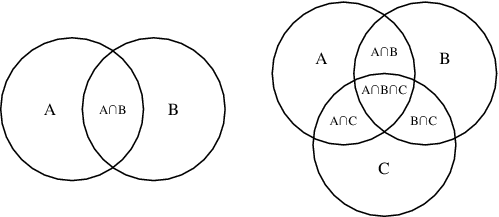
Denoted by \Omega is the set of all possible outcomes of an experiment.
\omega \subset \Omega - events
Event is called simple when |\omega| = 1
Event is called compound when |\omega| > 1

Where A, B, C are events and \bar A denotes the complement of A
P(A) = \frac{N(A)}{N}
P(A|B) = \frac{P(A \cap B)}{P(B)}
P(A \cap B) = P(A|B) \cdot P(B)
Events A_1, A_2, \cdots are exhaustive when \bigcup A_i = \Omega
When such events are exhaustive and mutually exclusive then: P(B) = \sum P(B \cap A_i) = \sum P(A_i) \cdot P(B | A_i)
Let A_1, A_2, \cdots be mutually exclusive exhaustive events. Then for any other event B and all j:
P(A|B) = \frac{P(B|A)\cdot P(A)}{P(B)}
or
P(A_j|B) = \frac{P(B|A_j) \cdot P(A_j)}{\sum P(B|A_i) \cdot P(A_i)}
Also:
P_B(A) = P(A|B)
When P(A \cap B) = P(A)P(B) then A and B are independent events
If A and B are independent then so are the complements:
For A_1, A_2, \cdots A_n
P(\bigcap A_i) = \prod P(A_i) for all combinations of A sets
Any combinations of complements are also mutually independent
P(\bigcup A_i) = 1 - \prod (1 - P(A_i))
Let an experiment have only 2 possible outcomes: failure (f) or success (s) where P(s) = p and P(f) = 1 - p = q
The probability that we obtain exactly k successes in the n independent Bernoulli trials is b(k; n, p) = \binom{n}{k}p^k(1-p)^{n-k}
lim_{n\to \infty}n\cdot p_n = \lambda > 0 then
lim_{n\to\infty}\binom{n}{k}p_n^k(1-p_n)^{n-k} = e^{-\lambda}\cdot\frac{\lambda^k}{k!}
F(k; \lambda) = \sum_{i=0}^k e^{-\lambda} \frac{\lambda^i}{i!}